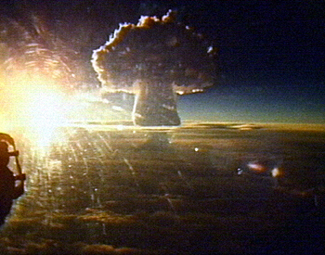Tsar Bomba
| Tsar Bomba | |
|---|---|

The Tsar Bomba mushroom cloud seen from a distance of 161 km (100 miles). The crown of the cloud is 56 km (35 miles) high at the time of the picture.
|
|
| Type | Thermonuclear weapon |
| Place of origin | Soviet Union |
| Production history | |
| Designer | Yulii Borisovich Khariton, Andrei Sakharov, Victor Adamsky, Yuri Babayev, Yuri Smirnov, Yuri Trutnev, and Yakov Zel'dovich. |
| Number built | 1 |
| Specifications | |
| Weight | 27,000 kilograms (60,000 lb) |
| Length | 8 metres (26 ft) |
| Diameter | 2.1 metres (6.9 ft) |
|
|
|
| Blast yield | 57 megaton TNT (210 PJ). |
Coordinates: 73°48′26″N 54°58′54″E / 73.80722°N 54.98167°E
Tsar Bomba (Russian: Царь-бомба; "Tsar-bomb") was the Western nickname for the Soviet RDS-220 hydrogen bomb (code name Ivan or Vanya), the most powerful nuclear weapon ever detonated. Its test on October 30, 1961 remains the most powerful human-made explosion in history. It was also referred to as Kuzkina mat (Russian: Кузькина мать; "Kuzma's mother"), possibly referring to Nikita Khrushchev's promise to show the United States a Kuzkina mat (an idiom roughly translating to "We'll show you!") at a 1960 session of United Nations General Assembly. Developed by the Soviet Union, the bomb had a yield of 57 megaton TNT (210 PJ). In theory, the bomb had a maximum yield of 100 megatons if it were to have included a U-238 tamper, but because only one bomb was built, this was never demonstrated. The single bomb was detonated at the Sukhoy Nos cape of Severny Island, part of Novaya Zemlya.
...
Wikipedia
